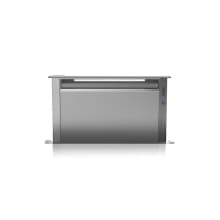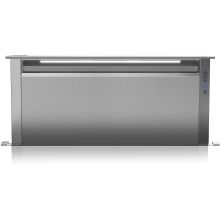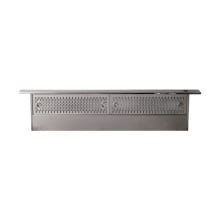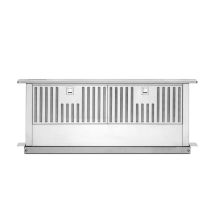The Low-Down on Downdraft and Pop-up Vents
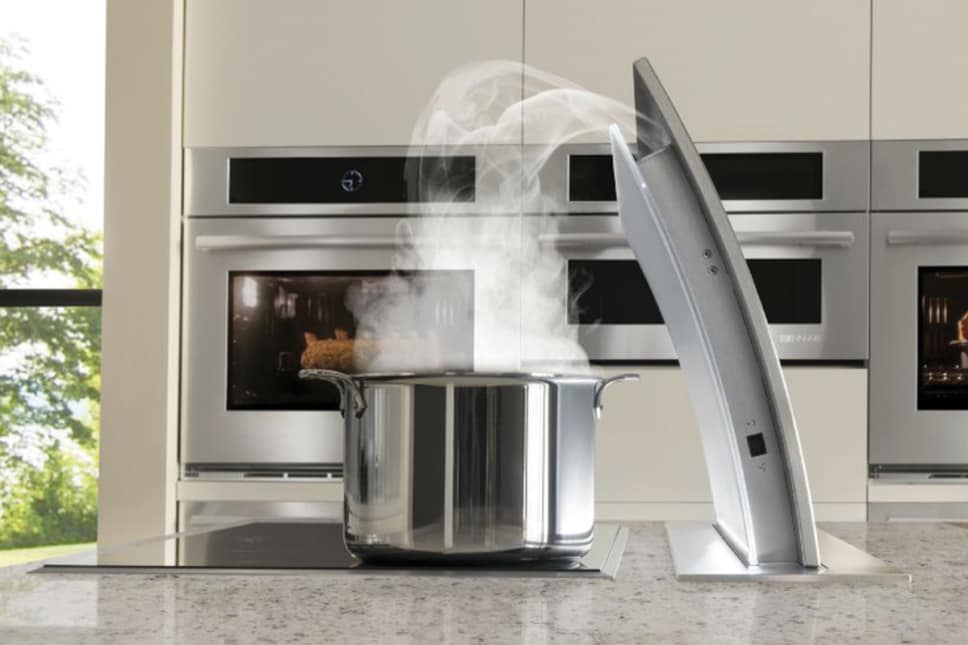
Every chef knows the importance of proper airflow in the kitchen. Obnoxious smells can cloud the air and some cooking fumes are actually harmful. That’s why every kitchen should have some form of ventilation system near the cooking area directly. Venting or filtering your cooking area keeps the air fresher, and keeps surfaces and kitchen decor cleaner.
The most common solution is the range hood, which pulls smoke, steam, grease, and food particles up from the stove top and outside through a vent. But the newest up and comer on the ventilation scene is the downdraft vent, also known as the pop-up vent.
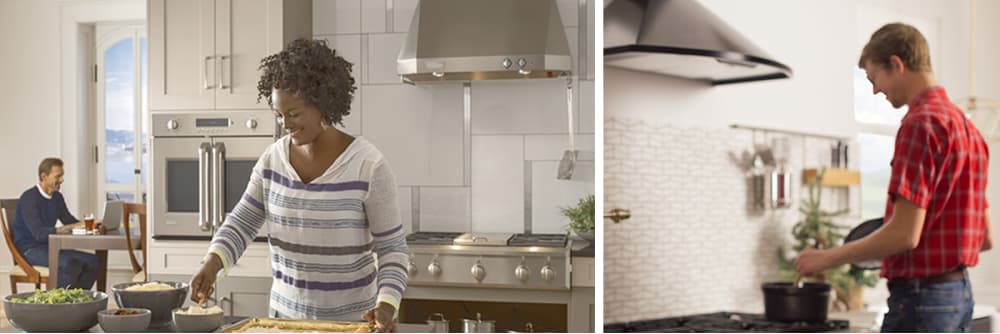
What Is a Range Hood?
A range hood is a ventilation system set at eye-level or higher, above the cooktop to pull problematic air particles safely away from your food prep areas. The cooking-contaminated air is pulled up into a vent in the ceiling and expelled outside of the home.
Range hoods often become a visual focal point of the kitchen because they are usually as large as the surface area of the stove top. While some will be hidden away under overhead cabinetry, professional kitchens are likely to have large vent hoods to capture a larger amount of cooking fumes and grease. The hoods are often very decorative and made from a variety of materials, from stainless steel to copper.
They can be difficult to design in small kitchens, island ranges, or kitchens with high ceilings. Range hoods have a higher capture area and plenty of power behind their filtration systems, but they take up a lot of space and are not always possible in multi-story homes. That’s where the downdraft vent comes in.
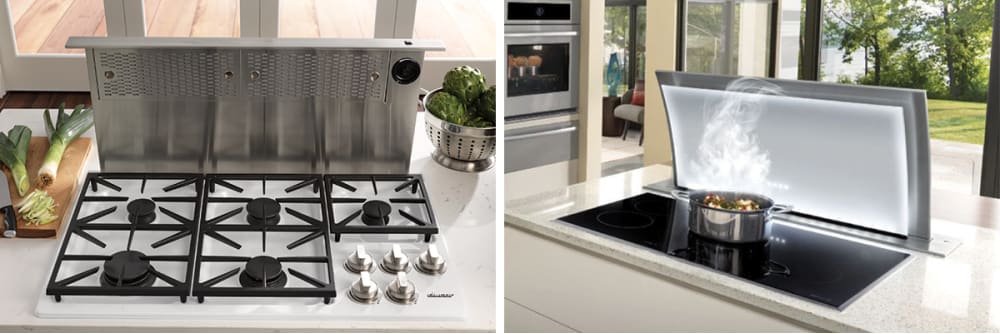
What Is a Downdraft Vent?
A downdraft vent is a circulation system designed to pull small, airbourne food particles away from the cooking area, just like the traditional bulky range hood. The important and characteristic difference, however, is that downdraft vents are located behind the cooktop, rather than above it. They pull the air horizontally away from the cooktop, and the vents send the collected contaminated air to be filtered down below the countertop. It collects the particles closer to the source, the vent area extending between 10” and 20” above the stove, preventing the cooking fumes’ free dispersal into the air you breathe.

These pop-up vents earned their name from their most distinctive design feature: the downdraft vents are installed on telescoping, hide-away platforms that disappear into the countertop behind the stove when not in use. Some are built into the range top directly, while others can be used to complement range tops and built-in ovens.
They are great for minimalist, open-floor plan kitchens, and for use on cooking islands. Pop-up vents are particularly useful in kitchens with high ceilings, where a bulky range hood would be otherwise in the way. They provide more control of the design of your kitchen because they can be hidden when not in use, making the ventilation system a purely functional detail.

Which Ventilation Works Best?
There are many factors to consider when choosing between a range hood or a downdraft vent, but it ultimately gets down to your household’s cooking habits. For regular meals, without a lot of open flame or flying grease, downdraft vents are quiet and efficient solutions. They are designed to work with smaller kitchens, or multi-level homes or apartments where extensive duct can’t be used to vent the fumes outdoors.
In commercial or professional kitchens, you’ll find a range hood. In those arenas, the design considerations come second to the performance of the vent. Downdraft vents are not designed to work with heavier, more demanding cooking projects, like indoor grilling. While they have strong circulation systems, some with a comparable CFM to a range hood, pop-up vents just don't have the advantage of surface area and physics on their side to capture the same amount of smoke, steam, and food particles.
Because of their placement, behind the stovetop where they pull air across the burners, downdraft vents that create too much airflow could extinguish the flames of a gas stovetop, or cool the pans and play havoc with the cooking temperatures. This places obvious limits on the capabilities of the pop-up vent, as opposed to a range hood which is installed much further from the flame source and can catch everything that rises.
Where a range hood can work with physics and collect the hot air that rises, filter it, and expel heat out of the house, a downdraft has to work against the natural air flow to pull that hot air sideways, at an angle and down through the ductwork to pull it from the working area. This can limit the power to do more than siphon, and the pop-up vent can get overwhelmed with too much smoke, steam, or grease. Many installations work best with a blower installed in the ductwork to help move the air out.
However, where a downdraft vent excels is in providing ventilation in those homes where it’s not possible to duct through the ceiling or wall. Instead, downdrafts can be routed through the floor, or along the underside of the kitchen cabinetry. Some models have recirculation kits that can filter the air to remove the fumes, with no external exhaust vent necessary. Even those vents that pull the air down through the stovetop help keep cooking smells and moisture out of the air, making life a little easier for the home chef. They provide alternatives to homes that otherwise would have limited or no ventilation, and they can complement overhead ventilation systems that could use a little extra help in more demanding kitchens.

What to Look for in a Downdraft Ventilation System
To get the most out of a pop-up vent, there are a few common features and traits among the vents to be aware of before you buy. These tips will help you narrow down the best fit for your needs.
Height - Check the height of your pots and pans before purchasing a downdraft vent. Whatever is released into the air above the level of the pop-up vent will be more likely to stay in the air, so you want to find a vent that is a few inches taller than the tallest pot.
Control panel - Look for a control panel that is well lit and readable, with easy to understand icons. Many models are touch-screen and easily cleaned.
Filters - Charcoal and other filters help control odors as well as harmful chemicals. Some models offer reminder lights when it’s time for filter replacement or maintenance. Note what kind of filters the system requires when considering purchases; look for filters that are easy to clean and replace as needed.
LED lighting - Many pop-up vents will now include LED lighting on their vents to help illuminate the cooking surface below. This feature is gaining popularity as low-cost LED becomes more common, and it can serve many purposes, from cooking prep to safety.
Power levels - The power capacity of the downdraft vent is determined by the CFM, or Cubic Feet per Minute, which measures how much air it can circulate. A higher CFM will move more air, but be sure to consider the different setting options available with the unit. Distinct low-to-high settings allow you to customize the fan use depending on what’s needed at the time.
Noise - Sone ratings measure how much noise a fan or blower makes. The lower the number, the quieter the appliance. Look for pop-ups with a low sone rating to keep the slim profile fan from interfering in conversations.
Recirculation kit - No ducting is required with a recirculation kit. The exhaust is instead filtered and sent down to the toe-kick space beneath the cabinet edge, along the floor.

Of course, the features that work best for you will depend on the kind of cooking you do and how often, but this can give you a head start on what to look for. Every manufacturer has their own offerings, so consider the features you want against the pricepoint and installation availability in your space.
Downdraft vents are not ideal in every home. They have their limitations and won’t easily meet the airflow demands of large-scale cooking projects. What they do well is provide powerful, slim-profile ventilation in designing both large and small spaces, and quiet, effective performance for the average home chef. Offering both style flexibility and installation options, they are well worth considering as a complement to any home kitchen ventilation system.

